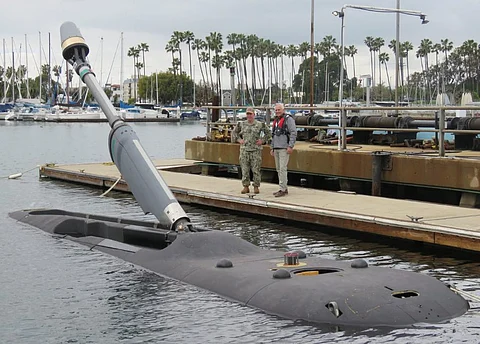

The US Navy has taken delivery of a new large autonomous submarine for testing purposes in line with the service's aim of expanding its undersea operational capabilities.
Given the official designation XLE0, the prototype extra large unmanned undersea vehicle (XLUUV) was built by aerospace and defence technology company Boeing. It is configured to accommodate a range of mission-specific payloads such as a new type of undersea mine currently under development. The navy is using the prototype as an evaluation vehicle to assess its capabilities prior to taking delivery of the five full-scale development XLUUVs.
"This class of vessel can undertake long-duration, persistent missions in ever-changing, contested waters," Boeing told Baird Maritime. "It is a first-of-type extreme endurance autonomous platform that was developed to combine capacity, mission flexibility, and reliability. It expands strategic and tactical options for missions that were previously not possible for earlier generations of unmanned undersea craft."
The builder said that, as with other autonomous systems for military operations, the XLUUV needed to be capable of making decisions and carrying out tasks without direct human intervention.
The XLUUV has a length of 51 feet (16 metres), a beam of 8.5 feet (2.6 metres), a displacement of 45.36 tonnes, and a payload bay measuring 34 feet (10 metres) long and with a volume of 2,000 square feet (186 square metres) and capacity for 7.26 tonnes. The craft can operate at depths as low as 11,000 feet (3,300 metres) and achieve a maximum speed of eight knots, though the optimal speed is between 2.5 and three knots.
Due to its size, the XLUUV does not require a host ship for launch, recovery, or payload replenishment. This helps free up some of the navy's surface assets for other critical roles, allowing the service to maximise its existing capability and permitting the craft itself to operate with full autonomy.
The size of the XLUUV also enables the installation of a hybrid propulsion package consisting of a diesel engine and a lithium-ion battery pack, giving the craft a far greater endurance compared to smaller unmanned craft. The batteries can be recharged even while the craft is out at sea, and each full charge will allow the craft to cover a distance of 150 nautical miles at optimal speed.
"The XLUUV's energy capacity is important because it enables a 6,500-nautical-mile range, thus allowing months-long missions to be conducted with limited human intervention," added Boeing. "The vehicle is capable of open ocean transit, bottom following, and long-duration moored operations on the seabed. Smaller UUVs do not have this endurance and range capacity."
The craft was designed with a large modular payload volume to permit a range of payloads for various missions including the deployment of UUVs and even aerial drones, making the XLUUV a mothership for these smaller vehicles.
The payload bay is designed for maximum flexibility and provides structure, electrical, and data interfaces to host a wide variety of sensors and other equipment. This then allows the XLUUV to carry a greater selection of equipment over greater distances than what is possible with smaller UUVs.
The craft is fitted with a battlespace unified communications terminal consisting of a broadband line of sight connection, S-band and C-band radios, four directional antennas, and sensors with low probability of intercept and detection, thus minimising exposure while operating in hostile environments.
Because of its range and payload capability, the XLUUV has the ability to undertake long-duration missions that are critical to ensuring undersea maritime dominance.
"We have stood up new manufacturing and assembly lines for large structure modules, new pressure vessels in size, material, and volume, one of the largest rechargeable batteries ever built, and a complex distributed system of vehicle control that enables fully autonomous operation," Boeing told Baird Maritime. "The stand-up of this complex new industry base was performed during the Covid-19 pandemic, under heavy travel restrictions, and global parts and raw material shortages, and we continue to look for opportunities to streamline our supply chain."
The builder added that the current testing process for the XLUUV has allowed the company to gain operational experience.
"As we proceed through the test and evaluation plan for the vehicle, we are gathering data and making adjustments based on lessons learned. These testing events include manoeuvring, navigation, buoyancy, reliable communications, vehicle characterisation, and endurance.
XLE0 began in-water testing in the spring of 2023 in Huntington Beach, California, and the craft was delivered to the navy the following December. The navy said that lessons learned from the craft's testing will be applied to a similar series of five XLUUVs, which Boeing will build and deliver in the future.
| XLE0 | |
| SPECIFICATIONS | |
| Type of vessel: | UUV – Naval |
| Owner: | US Navy |
| Builder: | Boeing, USA |
| Length overall: | 51 feet (16 metres) |
| Beam: | 8.5 feet (2.6 metres) |
| Displacement: | 45.36 tonnes |
| Capacity: | 7.26 tonnes |
| Maximum speed: | 8.0 knots |
| Cruising speed: | 3.0 knots |
| Range: | 6,500 nautical miles |
| Radios: | S-band; C-band |
| Type of fuel: | Diesel |
